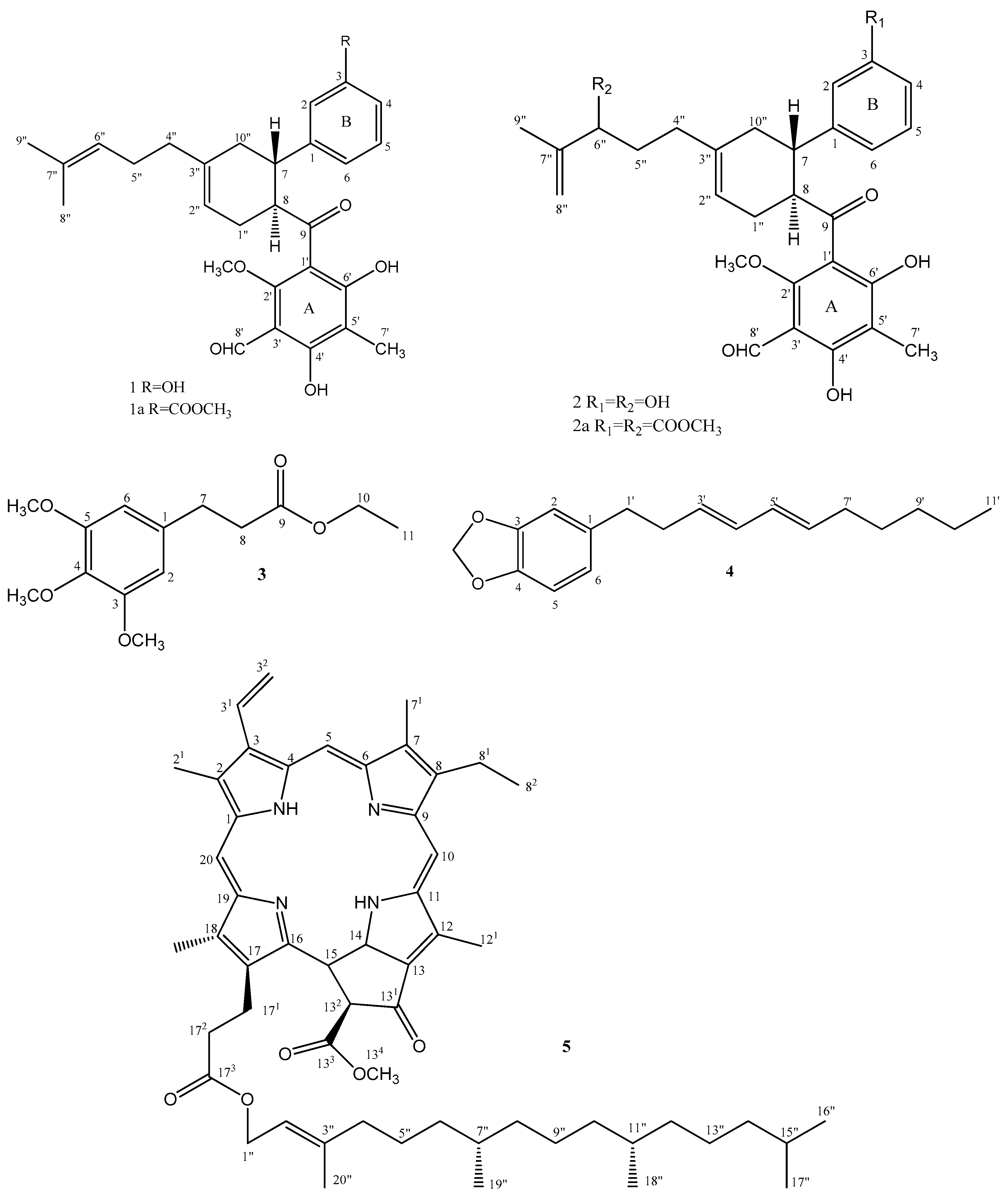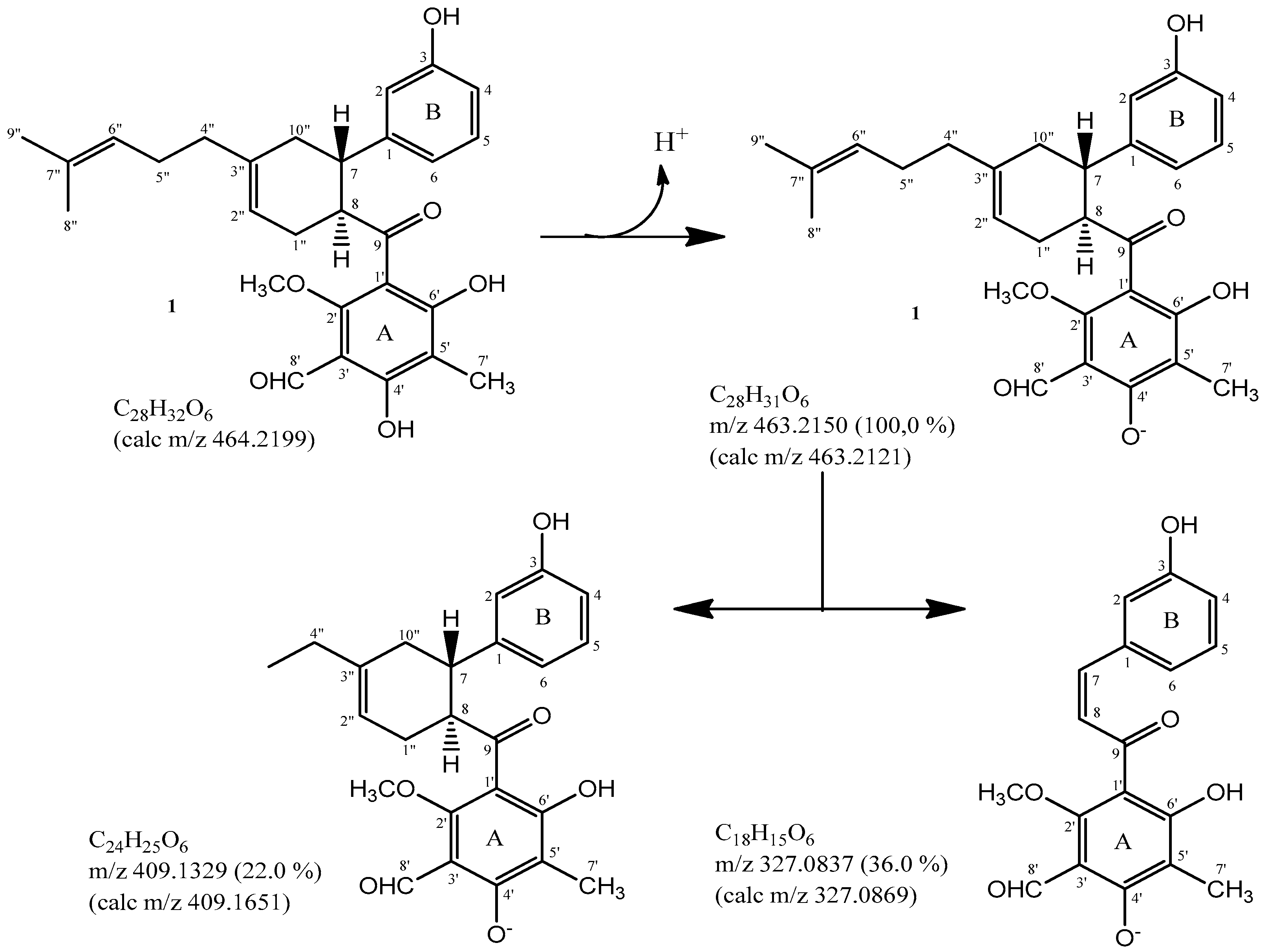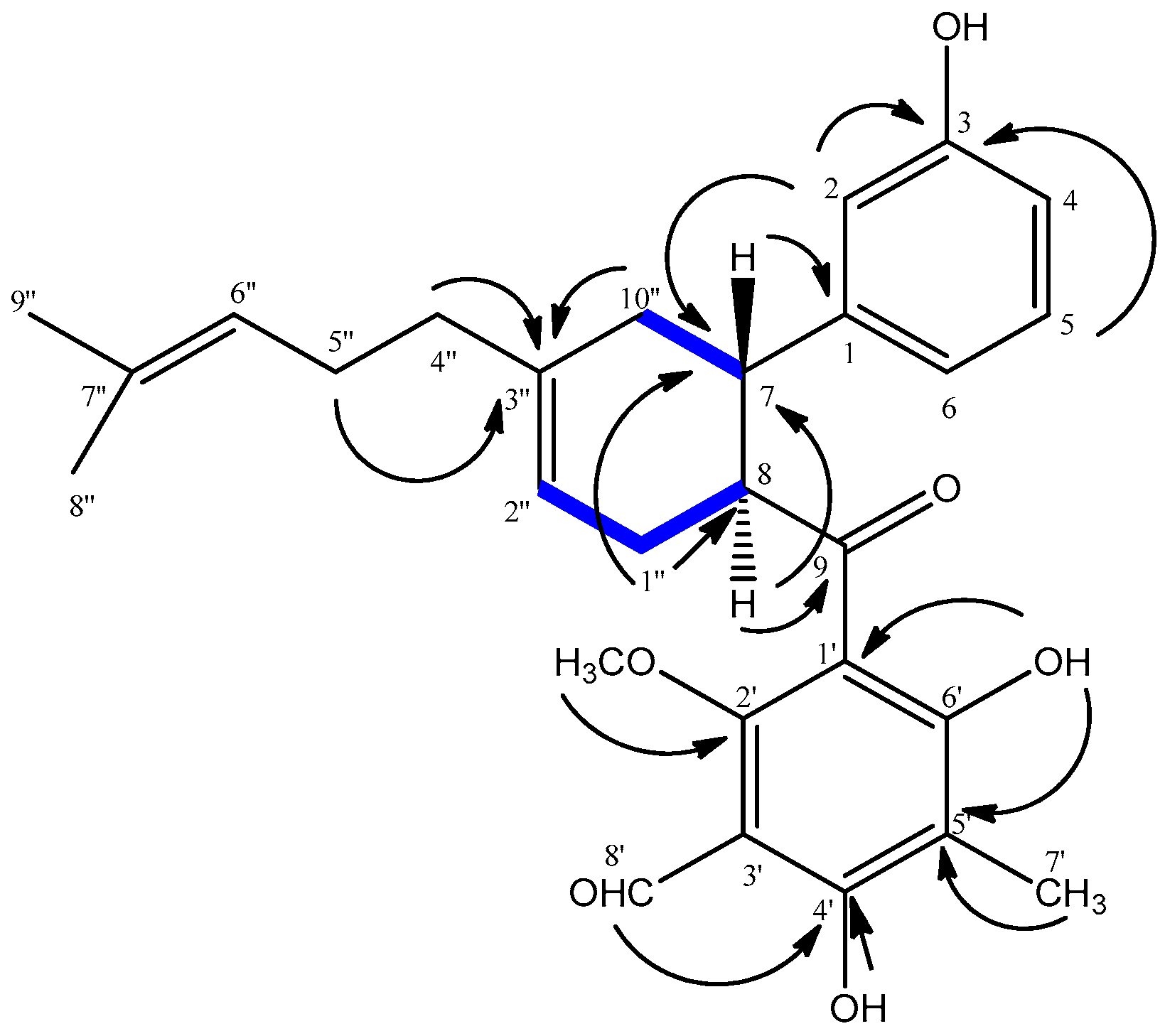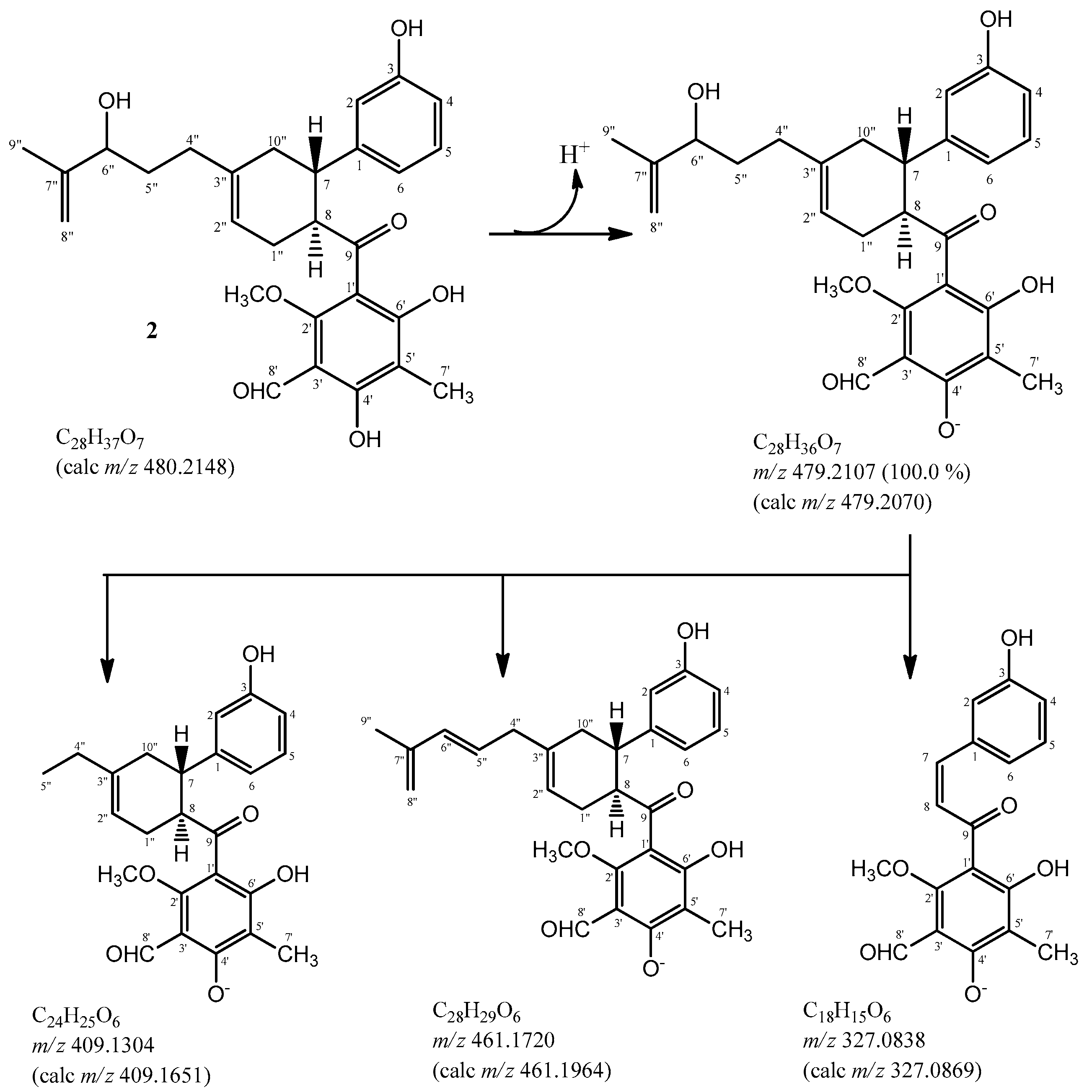Isolation of Monoterpene Dihydrochalcones from Piper montealegreanum Yuncker (Piperaceae)
Abstract
:1. Introduction
2. Results and Discussion
3. Materials and Methods
3.1. General Procedures
3.2. Plant Material
3.3. Extraction and Isolation
4. Conclusions
Supplementary Materials
Supplementary File 1Acknowledgments
Author Contributions
Conflicts of Interest
References
- Asri, S.F.M.; Ramli, E.S.M.; Soelaiman, I.N.; Noh, M.A.M.; Rashid, A.H.A.; Suhaimi, F. Piper sarmentosum effects on 11-hydroxysteroid dehydrogenase type 1 enzyme in serum and bone in rat model of glucocorticoid-induced osteoporosis. Molecules 2016, 21. [Google Scholar] [CrossRef]
- Jeffrey, C.S.; Leonard, M.D.; Glassmire, A.E.; Dodson, C.D.; Richards, L.A.; Kato, M.J.; Lee, A.D. Antiherbivore prenylated benzoic acid derivatives from Piper kelleyi. J. Nat. Prod. 2014, 77, 148–153. [Google Scholar] [CrossRef] [PubMed]
- Di Stasi, L.C.; Oliveira, G.P.; Carvalhaes, M.A.; Queiroz, M., Jr.; Tien, O.S.; Kakinami, S.H.; Reis, M.S. Medicinal plants popularly used in the Brazilian tropical atlantic forest. Fitoterapia 2002, 73, 69–91. [Google Scholar] [CrossRef]
- Parmar, V.S.; Jain, S.C.; Bisht, K.S.; Jain, R.; Tanela, P.; Jha, A.; Tyagi, O.D.; Prasad, A.D.; Wengel, J.; Olsen, C.E.; et al. Phytochemistry of the Genus Piper. Phytochemistry 1997, 49, 597–673. [Google Scholar] [CrossRef]
- Cardozo-Júnior, E.L.; Chaves, M.C.O. Caldensin, A new natural N-methylaristolactam from Piper caldense. Pharm. Biol. 2003, 41, 216–218. [Google Scholar] [CrossRef]
- Chaves, M.C.O.; Cunha, E.V.L. Two amides from Piper tuberculatum fruits. Fitoterapia 2001, 72, 197–199. [Google Scholar]
- Rukachaisirikul, T.; Siriwattanakit, P.; Sukcharoenphol, K.; Wongvein, C.; Ruttanaweang, P.; Wongwattanavuch, P.; Suksamrarn, A. Chemical constituents and bioactivity of Piper sarmentosum. J. Ethnopharmacol. 2004, 93, 173–176. [Google Scholar] [CrossRef] [PubMed]
- Ma, Y.; Han, G.Q.; Li, C.L.; Cheng, J.R.; Arison, B.H.; Hwang, S.B. Neolignans from Piper polysyphorum C. DC. Acta Pharm. Sin. 1991, 26, 345–350. [Google Scholar]
- Jenett-Siems, K.; Mockenhaupt, F.P.; Bienzle, U.; Gupta, M.P.; Eich, E. In vitro antiplasmodial activity of Central American medicinal plants. Trop. Med. Int. Health 1999, 4, 611–615. [Google Scholar] [CrossRef] [PubMed]
- Alves, H.S.; Souza, M.F.V.; Chaves, M.C.O. Three New Compounds from Piper montealegreanum Yuncker (Piperaceae). J. Braz. Chem. Soc. 2011, 22, 1610–1615. [Google Scholar] [CrossRef]
- Yuncker, T.G. New species of Piperaceae from Brazil. Bull. Inst. Bot. 1966, 3, 1–370. [Google Scholar]
- Queiroz, A.C.; Alves, H.S.; Silva, L.H.A.C.; Dias, T.L.M.F.; Santos, M.S.; Melo, G.M.A.; Campesatto, E.A.; Chaves, M.C.O.; Moreira, M.S.A. Antinociceptive and anti-inflammatory effects of flavonoids PMT1 and PMT2 isolated from Piper montealegreanum Yuncker (Piperaceae) in mice. Nat. Prod. Res. 2014, 28, 403–406. [Google Scholar] [CrossRef] [PubMed]
- Øyvind, M.A.; Kenneth, R.M. Flavonoids: Chemistry, Biochemistry, and Applications, 1st ed.; CRC Press: New York, NY, USA, 2006. [Google Scholar]
- Hano, Y.; Aida, M.; Nomura, T.; Ueda, S. A novel way of determining the structure of artonin I, an optically active Diels–Alder type adduct, with the aid of an enzyme system of Morus alba cell cultures. J. Chem. Soc. Chem. Commun. 1992, 17, 1177–1178. [Google Scholar] [CrossRef]
- Shibata, K.; Tatsukawa, A.; Umeoka, K.I.; Lee, H.S.; Ochi, M. Crinatusins, bioactive Diels-Alder adducts from Cyathocalyx crinatus. Tetrahedron 2000, 56, 8821–8824. [Google Scholar] [CrossRef]
- Yang, D.S.; Li, Z.L.; Yang, Y.P.; Xiao, W.L.; Li, X.L. A New Geranylated 2-Arylbenzofuran from Morus alba. Chin. Herb. Med. 2015, 7, 191–194. [Google Scholar] [CrossRef]
- Joshi, A.S.; Li, X.C.; Ninrod, A.C.; Elsohly, H.N.; Walker, L.A.; Clark, A.M. Dihydrochalcones from Piper longicaudatum. Plant Med. 2001, 67, 186–188. [Google Scholar] [CrossRef] [PubMed]
- Shirota, O.; Takizawa, K.; Sekita, S.; Satake, M.; Hirayama, Y.; Hakamata, Y.; Hayashi, T.; Yanagawa, T. Antiandrogenic natural Diels-Alder-type adducts from Brosimum rubescens. J. Nat. Prod. 1997, 60, 997–1002. [Google Scholar] [CrossRef] [PubMed]
- Alias, Y.; Awang, K.; Hadi, A.H.; Thoison, O.; Sévenet, T.; Païs, M. An antimitotic and cytotoxic chalcone from Fissistigma lanuginosum. J. Nat. Prod. 1995, 58, 1160–1166. [Google Scholar] [CrossRef] [PubMed]
- Vogt, T. Phenylpropanoid Biosynthesis. Mol. Plant 2010, 3, 2–20. [Google Scholar] [CrossRef] [PubMed]
- Brú, J.; Guzman, J.D. Folk medicine, phytochemistry and pharmacological application of Piper marginatum. Rev. Bras. Farmacogn. 2016, 26, 767–779. [Google Scholar] [CrossRef]
- Maciel, J.K.S.; Chaves, O.S.; Filho, S.G.B.; Teles, Y.C.F.; Fernandes, M.G.; Assis, T.S.; Fernandes, P.D.; Andrade, A.P.; Felix, L.P.; Silva, T.M.S.; et al. New alcamide and anti-oxidant activity of Pilosocereus gounellei A. Weber ex K. Schum. Bly. ex Rowl. (Cactaceae). Molecules 2016, 21. [Google Scholar] [CrossRef] [PubMed]
- Orjala, J.; Wright, A.D.; Behrends, H.; Folkers, G.; Sticher, O. Cytotoxic and antibacterial dihydrochalcones from Piper aduncum. J. Nat. Prod. 1994, 57, 18–26. [Google Scholar] [CrossRef] [PubMed]
- Haensel, R.; Wiess, D.; Schmidt, B. Fungistatische wirkung der kawadroge und ihrer inhaltsstoffe. Plant Med. 1966, 14, 1–9. [Google Scholar] [CrossRef]
- Orjala, J.; Wright, A.D.; Erdelmeier, C.A.J.; Sticher, O.; Rali, T. New Monoterpene-Substituted Dihydrochalcones from Piper aduncum. Helv. Chim. Acta 1993, 76, 1481–1488. [Google Scholar] [CrossRef]
- Falkiner, M.; Loder, J.W.; Russell, G.B.; Shelton, M. ω-Hydroxyisodillapiole, a new cinnamyl alcohol from Piper novae-hollandiae. Aust. J. Chem. 1972, 25, 2417–2420. [Google Scholar] [CrossRef]
- Leão da Silva, M.; Maia, J.G.S.; Mourao, J.C.; Pedreira, G.; Marx, M.C.; Gottlieb, O.R.; Magalhães, M.T. Essential oils from Amazonica VI. Acta Amaz. 1973, 3, 41–42. [Google Scholar]
- Galinis, D.L.; Wiemer, D.F.J. Villiramulins A and B: New phenol derivatives from Piper villiramulum. Org. Chem. 1993, 58, 7804–7807. [Google Scholar] [CrossRef]
- Bohm, B.A. Introduction to Flavonoids, 1st ed.; Harwood Academic Publishers: Vancouver, UK, 1998. [Google Scholar]
- Portet, B.; Fabre, N.; Roumy, V.; Gornitzka, H.; Bourdy, G.; Chevalley, S.; Sauvin, M.; Valentin, A.; Moulis, S. Activity-guided isolation of antiplasmodial dihydrochalcones and flavanones from Piper hostmannianum var. berbicense. Phytochemistry 2007, 68, 1312–1320. [Google Scholar] [CrossRef] [PubMed]
- Chaves, O.S.; Teles, Y.C.F.; Monteiro, M.M.O.; Junior, L.G.M.; Agra, M.F.; Braga, V.A.; Silva, T.M.S.; Souza, M.F.V. Alkaloids and Phenolic Compounds from Sida rhombifolia L. (Malvaceae) and Vasorelaxant Activity of Two Indoquinoline Alkaloids. Molecules 2017, 22. [Google Scholar] [CrossRef] [PubMed]
- Pavia, D.L.; Lampman, G.M.; Kriz, G.S. Introdução à Espectroscopia, 4th ed.; Cengage Learning: Boston, MA, USA, 2010. [Google Scholar]
- Jerz, G.; Arrey, T.N.; Wray, V.; Du, Q. Structural characterization of 132-hydroxy-(132-S)-phaeophytin a from leaves and stems of Amaranthus tricolor isolated by high-speed countercurrent chromatography. Innov. Food Sci. Emerg. Technol. 2007, 8, 413–418. [Google Scholar] [CrossRef]
- Silva, T.M.S.; Carvalho, M.G.; Braz-Filho, R. Estudo espectroscópico em elucidação estrutural de flavonoides de Solanum jabrense Agra & Nee e S. paludosum Moric. Quim. Nova 2009, 32, 1119–1128. [Google Scholar]
Sample Availability: Compound samples are no longer available. |






| 1 | 1a | 2 | 2a | |||||
|---|---|---|---|---|---|---|---|---|
| C Type | δC | δH | HMBC | δC | δC | δH | HMBC | δC |
| C-1 | 145.56 | 5, 6, 7 | 144.27 | 145.39 | 5 | 145.14 | ||
| CH-2 | 114.48 | 6.58, dd (2.5, 1.5) | 4, 6 | 120.24 | 114.40 | 6.56, m | 6, 7 | 120.30 |
| C-3 | 155.46 | 2, 5 | 150.63 | 155.52 | 5 | 150.66 | ||
| CH-4 | 113.30 | 6.48, ddd. (7.5, 2.5, 1.5) | 2, 6 | 119.43 | 113.35 | 6.47, md | 2, 6 | 119.35 |
| CH-5 | 129.35 | 6.94, t (7.5) | 128.98 | 129.27 | 6.92, dt (7.5, 2.0) | 127.82 | ||
| CH-6 | 119.82 | 6.64 dd (7.5, 1.5) | 2, 4 | 125.08 | 119.79 | 6.62, md | 2, 4, 7 | 124.97 |
| CH-7 | 45.19 | 3.01, dt (11.0, 5.5) | 2, 8, 2H-1″ | 44.84 | 45.08 | 3.00, dt (11.0, 5.5) | 2, 6 | 44.79 |
| CH-8 | 51.06 | 4.13, dt (11.0, 5.5) | 7, 2H-10″ | 50.93 | 51.01 | 4.09, m | 7 | 50.87 |
| C-9 | 209.55 | 8 | 209.21 | 209.40 | 209.03 | |||
| C-10 | 169.05 | 170.30 | ||||||
| C-1′ | 109.34 | HO-6′ | 108.95 | 109.28 | HO-6′ | 109.00 | ||
| C-2′ | 166.65 | CH3O-2′ | 166.60 | 166.60 | CH3O-2′ | 166.65 | ||
| C-3′ | 107.97 | 8′, HO-4′ | 108.22 | 107.98 | 8′, HO-4′ | 108.06 | ||
| C-4′ | 165.21 | 8′, HO-4′, 3H-7′ | 165.34 | 165.26 | HO-4′, 8′, 3H-7′ | 165.36 | ||
| C-5′ | 108.85 | 3H-7′, HO-4′, HO-6′ | 108.88 | 108.89 | 3H-7′, HO-4′, HO-6′ | 109.00 119.35 | ||
| C-6′ | 167.23 | HO-6′, 3H-7′ | 167.24 | 167.22 | HO-6′, 3H-7′ | 167.28 | ||
| CH2-1″ | 29.79 | 2.40, 2.38 | H-7, H-8 | 29.78 | 29.71 | 2.42, m 2.37, m | 29.79 | |
| CH-2″ | 118.73 | 5.53, m | 118.69 | 119.15 | 5.55, m | 119.53 | ||
| C-3″ | 137.41 | 2H-4″, 2H-10″, 2H-5″ | 137.28 | 137.17 | 136.36 | |||
| CH2-4″ | 37.23 | 2.02 m | 2H-5″ | 37.17 | 33.20 | 2.23-2.18, m | 30.60 | |
| CH2-5″ | 26.38 | 2.14 m | 2H-4″ | 26.33 | 32.91 | 1.65, m | 30.37 | |
| CH-6″ | 124.02 | 5.12 qt (7.0, 1.5) | 2H-5″, 3H-8″, 3H-9″ | 123.93 | 75.73 | 4.08, m | 2H-8″, 3H-9″ | 71.17 |
| C-7″ | 131.70 | H-6″, 3H-8″, 3H-9″ | 131.63 | 147.33 | 3H-9″ | 145.14 | ||
| CH3-8″ | 17.84 | 1.62 d (0.5) | 3H-9″ | 18.00 | 111.19 | 4.93, m 4.84, m | 6″, 3H-9″ | 112.98 |
| CH3-9″ | 25.69 | 1.70 d (1.0) | 3H-8″ | 25.66 | 17.63 | 1.73, s | 2H-8″ | 18.07 |
| CH2-10″ | 36.88 | 2.23, m, 2.20 m | H-7, H-8 | 36.78 | 36.67 | 2.23, m 2.18, m | 36.76 | |
| OCH3-2′ | 67.23 | 3.90, s | 67.27 | 67.24 | 3.90, s | 67.33 | ||
| CH3-7′ | 6.56 | 1.89, s | 6.52 | 6.57 | 1.87, s | 6.56 | ||
| CHO-8′ | 192.36 | 10.04, s | 192.37 | 192.35 | 10.03, s | 192.41 | ||
| HO-4′ | - | 12.46, s | 12.44, s | |||||
| HO-6′ | - | 12.88, s | 12.89, s | |||||
| CH3-11 | 20.86 | 21.08 | ||||||
| HMQC | HMBC | COSY | NOESY | |||
|---|---|---|---|---|---|---|
| δC | δH | 2JCH | 3JCH | 1H-1H | 1H-1H | |
| C | ||||||
| 1 | 135.80 | H-1′ | H-5, H-2′ | |||
| 3 | 147.47 | H-5, H-7 | ||||
| 4 | 145.54 | H-6, H-2, H-7 | ||||
| CH | ||||||
| 2 | 108.85 | 6.65 brd (1.5) | H-1′ | |||
| 5 | 108.05 | 6.70 d (8.0) | ||||
| 6 | 121.08 | 6.60 dd (8.0, 1.5) | H-2, H-1′ | |||
| 3′ | 130.84 | 5.58–5.52 (m) | H-1′ | H-2′ | H-5′ | |
| 4′ | 130.99 | 5.99 tt (14.5, 1.0) | H-2′, H-3′, H-6′ | |||
| 5′ | 130.08 | 5.99 tt (14.5, 1.0) | H-7′, H-3′ | H-3′, H-7′ | ||
| 6′ | 133.10 | 5.58–5.52 m | H-7′ | H-7′ | ||
| CH2 | ||||||
| 7 | 100.69 | 5.89 s | ||||
| 1′ | 35.62 | 2.59 t (7.5) | H-2′ | H-2, H-6, H-3′ | H-2′ | |
| 2′ | 34.70 | 2.30 dt (7.5, 8.0) | H-1′, H-3′ | H-4′ | H-1′, H-3′ | |
| 7′ | 32.59 | 2.02 dt (7.0, 7.5) | H-6′ | H-5′, H-8′ | H-6′, H-8′ | H-9′ |
| 8′ | 29.40 | 1.35–1.31 m | H-7′ | H-7′ | ||
| 9′ | 31.92 | 1.29–1.25 m | H-10′ | H-11′ | H-7′, H-11′ | |
| 10′ | 22.68 | 1.29–1.25 m | H-9′, H-11′ | H-11′ | ||
| CH3 | ||||||
| 11′ | 14.12 | 0.86 t (7.0) | H-10′ | H-9′ | ||
© 2017 by the authors. Licensee MDPI, Basel, Switzerland. This article is an open access article distributed under the terms and conditions of the Creative Commons Attribution (CC BY) license (http://creativecommons.org/licenses/by/4.0/).
Share and Cite
Alves, H.D.S.; Rocha, W.R.V.d.; Braz-Filho, R.; Chaves, M.C.d.O. Isolation of Monoterpene Dihydrochalcones from Piper montealegreanum Yuncker (Piperaceae). Molecules 2017, 22, 874. https://doi.org/10.3390/molecules22060874
Alves HDS, Rocha WRVd, Braz-Filho R, Chaves MCdO. Isolation of Monoterpene Dihydrochalcones from Piper montealegreanum Yuncker (Piperaceae). Molecules. 2017; 22(6):874. https://doi.org/10.3390/molecules22060874
Chicago/Turabian StyleAlves, Harley Da Silva, Wilma Raianny Vieira da Rocha, Raimundo Braz-Filho, and Maria Célia de Oliveira Chaves. 2017. "Isolation of Monoterpene Dihydrochalcones from Piper montealegreanum Yuncker (Piperaceae)" Molecules 22, no. 6: 874. https://doi.org/10.3390/molecules22060874





